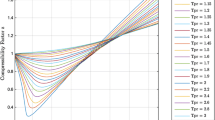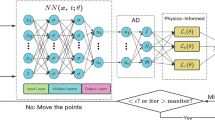Abstract
Maximizing economical asset of oil reservoirs is a simulation-based optimization involving large-scale simulation models. In this work we propose the use of reduced-order models for solving optimization problems in oil reservoir simulation using a Lagrangian barrier method for the treatment of nonlinear inequality constraints. The optimization with reduced-order models is done by employing a trust-region proper orthogonal decomposition (TRPOD) algorithm. In addition to the POD method, we also build a reduced-order model based on a discrete empirical interpolation method. In the algorithm, the first-order gradient of the objective function is computed by using the adjoint method, while the inverse of the second-order gradient is approximated using the BFGS method. The reduced-order models involve both the forward (state) and backward (adjoint) equations. Three optimization case examples in production optimization of oil reservoirs are used to study the method. They show that the TRPOD method works efficiently while simultaneously honoring the nonlinear constraints.




























Similar content being viewed by others
References
Aarnes JE, Gimse T, Lie KA (2007) An introduction to the numerics of flow in porous media using Matlab. Springer Verlag, New York
Agarwal A (2010) Advanced strategies for optimal design and operation of pressure swing adsorption processes. Ph.D. thesis, Carnegie Mellon University
Agarwal A, Biegler LT (2011) A trust-region framework for constrained optimization using reduced order modeling. Optim Eng 14:3–35. doi:10.1007/s11081-011-9164-0
Alexandrov NM, Lewis RM, Gumbert CR, Green LL, Newman PA (2001) Approximation and model management in aerodynamic optimization with variable-fidelity models. J Aircr 38(6):1093–1101
Astrid P, Weiland S, Willcox K, Backx T (2008) Missing point estimation in models described by proper orthogonal decomposition. IEEE Trans Autom Control 53(10):2237–2251
Audet C, Orban D (2006) Finding optimal algorithmic parameters using derivative-free optimization. SIAM J Optim 17:642–664
Aziz K, Settari A (1979) Petroleum reservoir simulation. Applied Science Publisher, London
Barrault M, Maday Y, Nguyen NC, Patera AT (2004) An ’empirical interpolation’ method: application to efficient reduced basis discretization of partial differential equations. Comptes Rendus Mathematique 339(9):667–672
Burkardt J, Gunzburger M, Lee HC (2006) Centroidal voronoi tessellation-based reduced-order modeling of complex systems. SIAM J Sci Comput 28(2):459–484
Byrd RH, Nocedal J, Waltz RA (2006) Knitro: an integrated package for nonlinear optimization. Large-Scale Nonlinear Optim 83:35–59. doi:10.1007/0-387-30065-1-4
Cardoso MA, Durlofsky LJ (2010) Linearized reduced-order models for subsurface flow simulation. J Comput Phys 229(3):681–700
Cardoso MA, Durlofsky LJ (2010) Use of reduced-order modeling procedures for production optimization. SPE J 15(2):426–435
Cardoso MA, Durlofsky LJ, Sarma P (2009) Development and application of reduced-order modeling procedures for subsurface flow simulation. Int J Numer Methods Eng 77(9):1322–1350
Chaturantabut S, Sorensen DC (2010) Nonlinear model order reduction via discrete empirical interpolation. SIAM J Sci Comp 32(5):2737–2764
Chaturantabut S, Sorensen DC (2011) Application of POD and DEIM on dimension reduction of non-linear miscible viscous fingering in porous media. Math Comput Model Dyn Syst 17(4):337–353
Christie MA, Blunt MJ (2001) Tenth SPE comparative solution project: a comparative of upscaling technique. SPE Reserv Eval Eng 4:308–317
Conn AR, Gould NIM, Toint PL (1997) A globally convergent Lagrangian Barrier algorithm for optimization with general inequality constraints and simple bounds. Math Comput 66(217):216–288
Conn AR, Gould NIM, Toint PL (2000) Trust-region methods. SIAM, Philadelphia
Davis TA (2006) Direct methods for sparse linear systems. SIAM, Philadelphia
Fahl M (2000) Trust-region methods for flow control based on reduced order modelling. Ph.D. thesis, Trier University
Heijn T, Markovinovic R, Jansen JD (2004) Generation of low-order reservoir models using system-theoretical concepts. SPE J 9(2):202–218
Hinze M, Volkwein S (2005) Proper orthogonal decomposition surrogate models for nonlinear dynamical systems: error estimates and suboptimal control. In: Benner P, Mehrmann V, Sorensen DC (eds) Reduction of large-scale systems, lecture notes in computational science and engineering, vol 45. Springer, Berlin
Krogstad S (2011) A sparse basis POD for model reduction of multiphase compressible flow. SPE-141973. In: Proceeding of the SPE 2011 reservoir simulation symposium
Krogstad S, Hauge VL, Gulbransen AF (2011) Adjoint multiscale mixed finite elements. SPE J 16(1):162–171. doi:10.2118/119112-PA
Lie KA, Krogstad S, Ligaarden IS, Natvig LR, Nilsen HM, Skafltestad B (2011) Open-source MATLAB implementation of consistent discretisations on complex grids. Comput Geosci Online First (2011). DOI 10.1007/s10596-011-9244-4. URL http://sintef.org/Projectweb/MRST/
Markovinovic R, Geurtsen EL, Heijn T, Jansen JD (2002) Generation of low-order reservoir models using POD, empirical gramians and subspace identification. In: Proc. 8th European conference on the mathematics of oil recovery (ECMOR). Freiberg, Germany, pp. E31-1-E31-10
Markovinovic R, Geurtsen EL, Jansen JD (2002) Subspace identification of low-order reservoir models. In: Proceeding of IV international conference on computational methods in water resources, Delft, The Netherlands. pp. 281–288
Markovinovic R, Jansen JD (2006) Accelerating iterative solution methods using reduced-order models as solution predictors. Int J Numer Methods Eng 68(5):525–541
Peaceman D (1983) Interpretation of well-block pressures in numerical reservoir simulation with nonsquare grid blocks and anisotropic permeability. SPE J 23(3):531–543
Robinson TD (2007) Surrogate-based optimization using multifidelity models with variable parameterization. Ph.D. thesis, Massachusetts Institute of Technology
Rwechungura R, Suwartadi E, Dadashpour M, Kleppe J, Foss B (2010) The norne field case -a unique comparative case study. SPE 127538. In: Proceeding of SPE intelligent energy conference and exhibition, Utrecht, The Netherlands
Sachs EW (2009) Adaptive trust region POD algorithms. URL http://www.mathematik.uni-trier.de/~schu/poster_DFG.pdf
Suwartadi E, Krogstad S, Foss B (2010) A Lagrangian-Barrier Function for Adjoint State Constraints Optimization of Oil Reservoir Water Flooding. In: Proceeding of IEEE conference on decision and control 2010, Atlanta, Georgia, USA
Suwartadi E, Krogstad S, Foss B (2012) Nonlinear output constraints handling for production optimization of oil reservoirs. Comput Geosci 16(2):499–517
van Doren JFM, Markovinovic R, Jansen JD (2006) Reduced-order optimal control of water flooding using proper orthogonal decomposition. Comput Geosci 10(1):137–158
Volkwein S (2003) Model reduction using proper orthogonal decomposition. In: Lecture Note. Institute of Mathematics and Scientific Computing. University of Graz. URL http://www.uni-graz.at/imawww/volkwein/POD.pdf
Wen Z, Durlofsky LJ, van Roy B (2011) Use of approximate dynamic programming for production optimization. SPE 141677. In: Proceeding of the SPE 2011 reservoir simulation symposium
Acknowledgments
The authors gratefully acknowledge support from the Integrated Operation Centers at NTNU (www.iocenter.no). The authors would also like to thank the anonymous referees for their valuable input.
Author information
Authors and Affiliations
Corresponding author
Rights and permissions
About this article
Cite this article
Suwartadi, E., Krogstad, S. & Foss, B. Adjoint-based surrogate optimization of oil reservoir water flooding. Optim Eng 16, 441–481 (2015). https://doi.org/10.1007/s11081-014-9268-4
Received:
Accepted:
Published:
Issue Date:
DOI: https://doi.org/10.1007/s11081-014-9268-4




